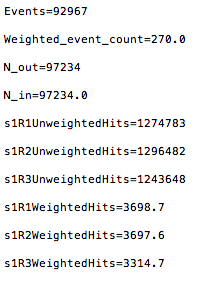Difference between revisions of "Weighted Occupancy"
| (11 intermediate revisions by the same user not shown) | |||
| Line 1: | Line 1: | ||
| + | |||
| + | <center><math> \underline{\textbf{Navigation} }</math> | ||
| + | |||
| + | [[Uniform_distribution_in_Energy_and_Theta_LUND_files|<math>\vartriangleleft </math>]] | ||
| + | [[VanWasshenova_Thesis#Moller_Scattering|<math>\triangle </math>]] | ||
| + | [[Relativistic_Units|<math>\vartriangleright </math>]] | ||
| + | |||
| + | </center> | ||
| + | |||
<pre>Total XSect=0.013866</pre> | <pre>Total XSect=0.013866</pre> | ||
=97234 incident electrons= | =97234 incident electrons= | ||
| Line 7: | Line 16: | ||
| − | <center><math>t_{sim}(75nA)=\frac{N_{in}}{\frac{ | + | <center><math>t_{sim}(75nA)=\frac{N_{in}}{\frac{75E-9\ A}{}\frac{1\ C}{1\ A}\frac{}{1\ s}\frac{1\ e^{-}}{1.602E-19\ C}}=\frac{97234\ e^{-}}{468,164,794,007\ e^{-}/s}=2.07E-7\ s</math></center> |
| − | <center><math>t_{sim}(100nA)=\frac{N_{in}}{\frac{ | + | <center><math>t_{sim}(100nA)=\frac{N_{in}}{\frac{100E-9\ A}{}\frac{1\ C}{1\ A}\frac{}{1\ s}\frac{1\ e^{-}}{1.602E-19\ C}}=\frac{97234\ e^{-}}{624,219,725,343\ e^{-}/s}=1.56E-7\ s</math></center> |
| Line 44: | Line 53: | ||
<center>Occupancy(100nA)=<math>\frac{3698.7}{270}\frac{1.56E-7}{250E-9}\frac{1}{112}\frac{100}{12}=0.637\%</math></center> | <center>Occupancy(100nA)=<math>\frac{3698.7}{270}\frac{1.56E-7}{250E-9}\frac{1}{112}\frac{100}{12}=0.637\%</math></center> | ||
| + | |||
| + | The non-time terms can be considered to be constant since they are either simple number such as 12 or functions which depend on the same variables such as the number of hits and number of events (Both terms are found by <math>\sigma N_{in}\rho l</math>,thus are only multiples of each other). We can simplify this expression by: | ||
| + | |||
| + | |||
| + | <center>Occupancy=<math>1.01926\%\frac{t_{sim}}{250E-9}</math></center> | ||
| Line 51: | Line 65: | ||
| − | <center><math>t_{sim}(75nA)=\frac{N_{in}}{\frac{ | + | <center><math>t_{sim}(75nA)=\frac{N_{in}}{\frac{75E-9\ A}{}\frac{1\ C}{1\ A}\frac{}{1\ s}\frac{1\ e^{-}}{1.602E-19\ C}}=\frac{N_{in}}{468,164,794,007\ e^{-}/s}=250E-9\ s\rightarrow N_{in}=117041.2\ e^{-}</math></center> |
| + | |||
| + | |||
| + | <center><math>t_{sim}(100nA)=\frac{N_{in}}{\frac{100E-9\ A}{}\frac{1\ C}{1\ A}\frac{}{1\ s}\frac{1\ e^{-}}{1.602E-19\ C}}=\frac{N_{in}}{624,219,725,343\ e^{-}/s}=250E-9\ s\rightarrow N_{in}=156054.9\ e^{-}</math></center> | ||
| + | |||
| + | |||
| + | CEBAF has a bunch redition rate of 499MHz for hall B. For a current of 50nA, this implies: | ||
| + | |||
| + | <center><math>\frac{\frac{50E-9\ A}{}\frac{1C}{1A}\frac{}{1s}\frac{1\ e^{-}}{1.602E-19\ C}}{499E6\ Hz}=\frac{\frac{312,109,863,672\ e^{-}}{s}}{499E6\ Hz}=625\ e^{-}</math></center> | ||
| + | |||
| + | |||
| + | If we declare that every 2ns consists of a bunch of 625 electrons each, then | ||
| + | |||
| + | <center><math>\frac{78027.5\ e^{-}}{\left(\frac{625\ e^{-}}{2E-9\ s}\right)}=124.844\times 2E-9\ s=2.50E-7\ s</math></center> | ||
| + | |||
| + | |||
| + | <center><math>\frac{117041.2\ e^{-}}{\left(\frac{625\ e^{-}}{2E-9\ s}\right)}=187.266\times 2E-9\ s=3.75E-7\ s</math></center> | ||
| + | |||
| + | |||
| + | <center><math>\frac{156054.9\ e^{-}}{\left(\frac{625\ e^{-}}{2E-9\ s}\right)}=249.688\times 2E-9\ s=4.99E-7\ s</math></center> | ||
| + | |||
| + | |||
| + | If we use these times as the times of simulation: | ||
| + | |||
| + | <center>Occupancy(50nA)=<math>1.01926\%\frac{2.50E-7\ s}{250E-9}=1\%</math></center> | ||
| − | |||
| + | <center>Occupancy(75nA)=<math>1.01926\%\frac{3.75E-7\ s}{250E-9}=1.5\%</math></center> | ||
| + | |||
| + | |||
| + | <center>Occupancy(100nA)=<math>1.01926\%\frac{4.99E-7\ s}{250E-9}=2\%</math></center> | ||
==Method 2== | ==Method 2== | ||
| Line 79: | Line 120: | ||
| − | <center>Occupancy(50nA)=<math>\frac{3698.7}{270}\frac{3.11E-7}{250E-9}\frac{1}{112}\frac{100}{12}= | + | <center>Occupancy(50nA)=<math>\frac{3698.7}{270}\frac{250E-9}{3.11E-7}\frac{1}{112}\frac{100}{12}=0.82\%</math></center> |
| + | |||
| + | |||
| + | |||
| + | <center>Occupancy(75nA)=<math>\frac{3698.7}{270}\frac{250E-9}{2.07E-7}\frac{1}{112}\frac{100}{12}=1.23\%</math></center> | ||
| + | |||
| + | |||
| + | |||
| + | <center>Occupancy(100nA)=<math>\frac{3698.7}{270}\frac{250E-9}{1.56E-7}\frac{1}{112}\frac{100}{12}=1.63\%</math></center> | ||
| + | ---- | ||
| − | |||
| + | <center><math> \underline{\textbf{Navigation} }</math> | ||
| + | [[Uniform_distribution_in_Energy_and_Theta_LUND_files|<math>\vartriangleleft </math>]] | ||
| + | [[VanWasshenova_Thesis#Moller_Scattering|<math>\triangle </math>]] | ||
| + | [[Relativistic_Units|<math>\vartriangleright </math>]] | ||
| − | + | </center> | |
Latest revision as of 19:59, 29 December 2018
Total XSect=0.013866
97234 incident electrons
Method 1
Using the unweighted amounts
Using the weighted amounts
The non-time terms can be considered to be constant since they are either simple number such as 12 or functions which depend on the same variables such as the number of hits and number of events (Both terms are found by ,thus are only multiples of each other). We can simplify this expression by:
If 250ns is the time limit, then solving the time of simulation backwards will give the number of incident electrons within that window.
CEBAF has a bunch redition rate of 499MHz for hall B. For a current of 50nA, this implies:
If we declare that every 2ns consists of a bunch of 625 electrons each, then
If we use these times as the times of simulation:
Method 2
Using the unweighted amounts
Using the weighted amounts
